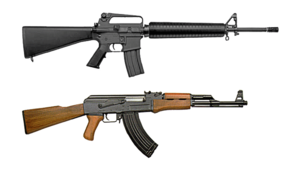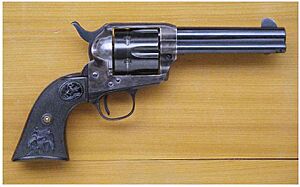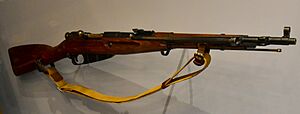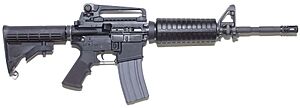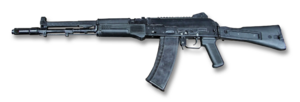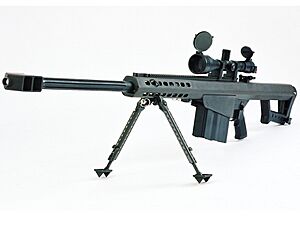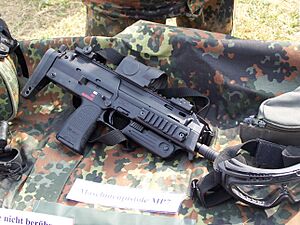Firearm facts for kids
A firearm is a type of gun that uses an explosive charge to shoot a projectile. It's made to be easily carried and used by one person.
The first firearms appeared in China around the 10th century. They were bamboo tubes filled with gunpowder and small pellets, attached to spears. These were called "fire lances" and could be used by one person. They were very effective in battles, like the siege of De'an in 1132. Later, in the 13th century, these bamboo tubes were replaced with metal ones, creating the "hand cannon." This technology slowly spread across Eurasia in the 14th century.
Older firearms used black powder to push the projectile. But modern firearms use smokeless powder or other powerful explosives. Most modern firearms (except for smoothbore shotguns) have spiral grooves inside their barrels. These grooves make the projectile spin, which helps it fly straight and accurately.
Modern firearms are often described by their caliber, which is the diameter of the barrel. For pistols and rifles, this is given in millimeters or inches (like 7.62mm or .308 in.). For shotguns, it's called gauge (like 12 ga. or 20 ga.). They are also described by how they load and fire (like muzzleloader, breechloader, semi-automatic, or fully automatic).
Shooters aim firearms using their hand-eye coordination, often with iron sights or special scopes. Pistols are usually accurate up to about 100 metres (110 yd; 330 ft). Most rifles can be accurate up to 500 metres (550 yd; 1,600 ft) with iron sights, and even further with scopes. Special sniper rifles can hit targets more than 2,000 metres (2,200 yd) away. It's important to remember that bullets can be dangerous much further than their accurate range, so safety distances are always much larger.
Contents
- Different Kinds of Firearms
- Handguns: Small and Portable
- Long Guns: Two-Handed Power
- Rifles: Accuracy and Range
- Shotguns: Spreading the Shot
- Carbines: Shorter and Handier
- Assault Rifles: Modern Military Standard
- Battle Rifles: Full-Power Force
- Sniper Rifles: Precision at a Distance
- Automatic Rifles: Continuous Firepower
- Machine Guns: Sustained Fire
- Submachine Guns: Close-Quarters Compactness
- Personal Defense Weapons: Bridging the Gap
- See also
Different Kinds of Firearms
A firearm is a weapon with a barrel that shoots one or more projectiles. It works by quickly expanding hot gas from burning a chemical propellant, like black powder or smokeless powder. This gas pushes the projectile out of the barrel.
In the military, firearms are grouped into "heavy" and "light" weapons based on how easily infantry (foot soldiers) can carry them. Light firearms can be carried by one soldier, though some might need a small team to work best. Heavy firearms are too big and heavy to carry on foot. They need to be put on a weapons platform like a stand, wheeled cart, vehicle, aircraft, or water vessel to be moved or used effectively.
A special group of light firearms are called small arms. These are compact enough for one soldier to use completely. Small arms include handguns like pistols, revolvers, and derringers. They also include long guns like rifles, shotguns, submachine guns, and machine guns.
Many companies around the world make firearms. Some of the biggest include Browning, Remington, Colt, Ruger, and Smith & Wesson from the United States; Heckler & Koch, SIG Sauer, and Walther from Germany; Glock and Steyr Arms from Austria; FN Herstal from Belgium; Beretta from Italy; Norinco from China; and Rostec and Kalashnikov from Russia.
In 2018, a study found that there were over one billion firearms worldwide. About 857 million (85%) were owned by regular people. In the U.S. alone, civilians owned 393 million firearms, which is about 46% of all civilian-owned guns globally. This means there were about 120.5 firearms for every 100 people in the U.S. Armies around the world had about 133 million firearms (13% of the total), with Russia and China owning the most. Police forces had about 23 million (2%).
Handguns: Small and Portable
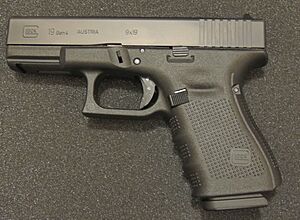
A handgun is a firearm that you can use with just one hand. They are the smallest type of firearm. Handguns are often used as sidearms (a secondary weapon), for concealed carry (carrying a gun hidden), or as backup weapons for self-defense.
Handguns come in two main types:
- Pistols have a single firing chamber built into the back of the barrel. They are often loaded using magazines that hold several bullets.
- Revolvers have multiple firing chambers in a spinning cylinder. Each chamber holds one bullet.
- Derringers are a broader group for any handgun that isn't a traditional pistol or revolver, usually very small.
There are many kinds of handguns for different uses. Some are single-shot, meaning you load one bullet at a time. Others are semi-automatic, firing one shot each time you pull the trigger. Some are even automatic, firing many shots as long as you hold the trigger.
Famous pistols include the Glock, Browning Hi-Power, and M1911 pistol. Well-known revolvers include the Colt Single Action Army and Smith & Wesson Model 10.
Long Guns: Two-Handed Power
A long gun is any firearm with a long barrel, usually between 10 to 30 inches (250 to 760 mm) long. Unlike handguns, long guns are designed to be held and fired with both hands. They are often braced against the hip or shoulder for better aim. The main part of the gun, where the trigger is, is attached to a "stock" made of wood, plastic, or metal. This stock has a front grip, a rear grip, and often a part that rests on your shoulder, called the "butt."
Early long guns, from the 1400s to the mid-1800s, were usually smoothbore (no grooves inside the barrel) and fired a single round ball. These were called muskets or arquebuses. Since the 1800s, many different types of long guns have been made for various purposes.
Rifles: Accuracy and Range
A rifle is a long gun with rifling (spiral grooves) inside its barrel. These grooves make the bullet spin as it leaves the barrel, which helps it fly straight and hit targets accurately over long distances. Rifles came from muskets but are much more precise.
Because they are so accurate and can shoot far, rifles are very popular. Armies use them as their main service rifles. Police use them for accurate long-range shooting. Civilians use them for hunting, shooting sports, and self-defense.
Many types of rifles exist. Some are shorter, like carbines. Others are named for their use, like semi-automatic rifles (one shot per trigger pull) or automatic rifles (continuous fire). They also differ in how they load, such as bolt-action or lever-action rifles.
Examples of famous rifles include the Henry rifle, Winchester rifle, M1 Garand, and AKM.
Shotguns: Spreading the Shot
A shotgun is a long gun that usually has a smoothbore barrel, meaning it doesn't have rifling. Shotguns are designed to fire many small pellets (called "shot") in one go. These pellets spread out as they fly, making a cluster of impact points. This means shotguns are less accurate and have a shorter range than rifles.
Shotguns can also fire single, solid projectiles called slugs. They can also use special "less lethal" rounds like bean bags or tear gas for riot control or door breaching. All shotgun ammunition comes in shotgun shells, which are loaded into the gun.
Shotguns are similar to rifles in some ways. Both came from early long guns like muskets. Both have different loading styles, like pump-action or semi-automatic. They are also popular with military, police, and civilians. However, shotguns are less common in modern combat because their accuracy is lower and they are less effective against modern armor. They are still popular for hunting, clay pigeon shooting, and home defense.
Double-barreled shotguns have two barrels side-by-side or one above the other. This lets them fire two shots quickly.
Examples of shotguns include the Winchester Model 1897, Remington Model 870, and Mossberg 500.
Carbines: Shorter and Handier

A carbine is a long gun, usually a rifle, that has a shorter barrel than a standard rifle. It's still big enough to be called a long gun. The difference in length can vary. For example, the standard Heckler & Koch G36 rifle has a 480mm barrel, while its G36K carbine version has a 318mm barrel. Some carbines are completely new designs, like the M1 carbine, not just shorter versions of existing rifles. Carbines work very similarly to rifles, with the same loading actions. Sometimes, a full-size rifle with a shortened barrel is called a "short barreled rifle" (SBR).
The smaller size of a carbine makes it lighter and easier to move around. This is great for close-quarters combat (fighting in tight spaces) and for storing in small areas. Because of this, carbines are popular with special forces and police tactical units. They have become very common since the late 1990s because they are familiar to use and have more power than submachine guns.
Carbines are also used by military personnel who need a gun but where a full-size rifle would get in the way of their main job, like engineers or officers. Civilians also like carbines for their size, space, and power.
Examples of carbines include the Winchester Model 1892, SKS, and M4 carbine.
Assault Rifles: Modern Military Standard
An assault rifle is usually defined as a rifle that can fire either single shots or automatically (many shots quickly). It uses a special type of bullet called an "intermediate cartridge" (like 5.56×45mm NATO or 7.62×39mm). These rifles are fed by detachable magazines. Assault rifles are also typically smaller than full-sized rifles.
The first assault rifle was the StG 44, made by Nazi Germany during World War II. Since then, assault rifles have become incredibly popular with armies and other armed groups because they are so versatile. They have been the main type of service rifle used by militaries since the mid-20th century. Some assault rifles have a "bullpup" design, where the handle and trigger are in front of the firing chamber, making the gun shorter.
Famous assault rifles include the Kalashnikov rifles (like the AK-47 and AKM) and the American M4 carbine and M16 rifle.
Battle Rifles: Full-Power Force
A battle rifle is usually a semi-automatic or selective-fire rifle that is larger or longer than an assault rifle. It uses a "full-power" bullet (like 7.62×51mm NATO). This term was created later to tell the difference between older, powerful rifles like the M1 Garand and newer assault rifles that use smaller, "intermediate" bullets. However, the term is sometimes used for similar modern rifles too.
Battle rifles are used for similar purposes as assault rifles, mainly by foot soldiers. Some people prefer battle rifles because their more powerful bullets hit harder, even though they have more recoil (kickback). Some special sniper rifles are made from battle rifles, like the Mk 14 Enhanced Battle Rifle.
Examples of battle rifles include the FN FAL and M1 Garand.
Sniper Rifles: Precision at a Distance
A sniper rifle is a very powerful and accurate rifle, often bolt-action or semi-automatic. It can shoot much farther than a standard rifle. While any rifle with a telescopic sight (scope) and a bipod (two-legged stand) can be called a sniper rifle, most are specially built for sniping. Some are modified versions of existing rifles.
Related types of rifles include:
- Anti-materiel rifles: These are high-caliber rifles designed to destroy enemy equipment like vehicles or supplies.
- Anti-tank rifles: These were anti-materiel rifles specifically made to fight early armored vehicles. They are mostly outdated now.
- Scout rifles: These are generally short, lightweight, and portable sniper rifles.
- Designated marksman rifles (DMRs): These are semi-automatic, accurate rifles that fill the gap between sniper rifles and regular rifles. They are used by designated marksmen in military squads.
Examples of sniper rifles include the M40 rifle and Accuracy International AWM. Famous anti-materiel rifles include the Barrett M82. The SVD is a well-known designated marksman rifle.
Automatic Rifles: Continuous Firepower
An automatic rifle is a rifle that can fire continuously as long as the trigger is held down. Most assault rifles and battle rifles are types of automatic rifles. They were invented as a new kind of rifle that could fire automatically, unlike the single-shot or semi-automatic rifles common at the time. They usually hold fewer bullets than machine guns.
Sometimes, automatic rifles are considered a type of light machine gun. People often confuse automatic rifles with machine guns, or laws might define them similarly. In many places, automatic rifles and other automatic firearms are not allowed for civilians or are very strictly controlled.
Examples of automatic rifles include the Cei-Rigotti, Lewis gun, and M1918 Browning automatic rifle.
Machine Guns: Sustained Fire
A machine gun is a fully-automatic firearm that fires rifle bullets. It's designed to provide continuous, automatic fire, unlike the single shots or short bursts of standard rifles. Machine guns are often fed by long belts of ammunition, but some use box, drum, or pan magazines. They usually fire very fast and hold a lot of ammunition. They are often used to provide suppressive fire (firing to keep the enemy's heads down) to help soldiers advance or defend positions.
Because they are so powerful, machine guns are often put on military vehicles and military aircraft. Many machine guns can be used by one soldier, but some are "crew-served," meaning they need a team of soldiers to operate them.
Machine guns are divided into three types:
- Light machine guns: Used by one soldier, often magazine-fed with intermediate bullets.
- Medium machine guns: Belt-fed with full-power bullets. Can be used by one person but work best with a crew.
- Heavy machine guns: Too big and heavy to carry. They are mounted on a tripod or vehicle and need a crew.
A general-purpose machine gun is a flexible type that can work as a light, medium, or even heavy machine gun. A squad automatic weapon (SAW) is a portable light machine gun or modified rifle that gives a small group of soldiers quick, direct fire.
Examples of machine guns include the Maxim gun, M2 Browning, Bren light machine gun, and M249 light machine gun.
Submachine Guns: Close-Quarters Compactness
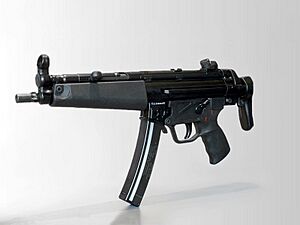
A submachine gun is a carbine that uses small-caliber handgun cartridges (like 9×19mm Parabellum or .45 ACP). They are not called machine guns because they use smaller bullets, hence the "sub-" part of their name. Submachine guns are known for firing very fast, having automatic fire, and low recoil (kickback). Many are designed to be very compact for use in tight spaces or easy storage. Some are even designed to look and feel like pistols, though they usually need two hands to use.
Submachine guns are great for close-quarters combat (fighting in small areas) and are cheap to make. They were very common in armies during much of the 20th century. However, they have been replaced in most combat roles by rifles and carbines. This is because submachine guns have a shorter effective range and their bullets don't go through modern body armor very well. Still, they are popular with special forces and police because they are effective in close-quarters and their bullets are less likely to go through targets and hit something else.
Examples of submachine guns include the MP 18, Thompson submachine gun, Uzi, and Heckler & Koch MP5.
Personal Defense Weapons: Bridging the Gap
A personal defense weapon (PDW) is like a submachine gun, but it fires special ammunition that performs more like rifle bullets. These are often called "sub-intermediate" cartridges. PDWs combine the fast automatic fire, low recoil, and compact size of submachine guns with the versatility, penetration, and range of rifles. They are a mix between submachine guns and carbines.
PDWs were created to give soldiers in support roles (like vehicle crews, engineers, or logistics personnel) a good way to defend themselves. These soldiers might not carry powerful firearms normally, and handguns or submachine guns might not be strong enough against attackers. PDWs allow these personnel to defend themselves effectively until help arrives. They are usually automatic firearms, so they are often not available for civilians to buy.
Examples of personal defense weapons include the FN P90 and Heckler & Koch MP7.
See also
 In Spanish: Arma de fuego para niños
In Spanish: Arma de fuego para niños
- Ballistics (how projectiles move)
- Gunsmith (someone who makes or repairs guns)
- Shooting range (a place for target practice)
- Shooting sport (sports involving shooting)
- List of shooting sports organizations
- International Biathlon Union
- International Shooting Sport Federation


